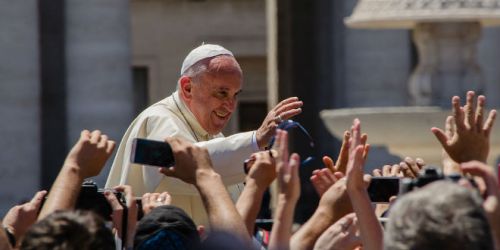Guest post by Irene S. Wu
The visit of Pope Francis to the United States reminded us what is good about the Church: the pull of an ancient creed, the call to a purpose bigger than ourselves, and the comfort of belonging to a caring community. There are many leaders of important institutions, indeed heads of state, who wish their visits would generate the same excitement.
 That Catholics welcomed the Pope’s visit is to be expected. That so many others shared their sentiments—Protestants, who in the olden days rebelled against the Catholic Church for one reason or another; others of competing faiths; and possibly a considerable contingent with no faith at all—is the surprise. This large crowd, this contending mix of people, is a trust community.
That Catholics welcomed the Pope’s visit is to be expected. That so many others shared their sentiments—Protestants, who in the olden days rebelled against the Catholic Church for one reason or another; others of competing faiths; and possibly a considerable contingent with no faith at all—is the surprise. This large crowd, this contending mix of people, is a trust community.
Trust communities are one in a continuum of social organizations. At one end are networks, which are largely nonhierarchical groups of loosely connected individuals. At the other end are institutions—like the Catholic Church—with hierarchies, formal rules and procedures, membership lists, budgets, and mission statements. In between are trust communities: groups with a shared cause or identity, held together by communication and exchange rather than common locale.
Trust communities can be small. Our towns, counties, sports associations, civic societies, and cultural appreciation clubs are trust communities that are a powerful draw on our time, attention, and loyalty. Also, there are the global trust communities—now more easily accessible to all of us than before—like the Olympics, the World Cup, the environmental movement, or the fight for human rights.
Trust communities are expansive and diverse. A nation’s trust community includes ministries and departments, the media who observe and report, the citizens who engage, the critics who complain, the rivals who compete, and the enemies who war against. Who is outside the trust community? Those who do not care, who pay no heed, and who are unaware. The challenge for many heads of state is to get attention and be relevant—in other words, to expand their trust community.
Trust communities are built on sharing stories and helping each other. Robert Putnam and Lewis Feldstein talked about the power of the personal narrative in building shared attitudes, values, and identities. Trading stories gives people a chance to discover commonality and build understanding. This can involve a visit in person, a timeline on Facebook, or even a Twitter feed. Talking and helping each other is also key. James Walker and Nobel Prize winner Elinor Ostrom used empirical experiments that showed communication substantially increased cooperation in many types of social dilemmas. Reciprocity builds trust.
In the places the Pope visited, preparation required a lot of coordination. Volunteers and community chiefs, religious leaders, and school children all pitched in to help. The process of preparation, the reciprocity and storytelling involved, strengthened the trust community. As the Pope continues to deliver his message, we will see how much social capital this trust community can build to propel forward the Church’s work.
The Pope’s visit was a reminder that money and guns are not the only source of power in the world. Ideas, sharing, cooperation, and trust are forces to contend with as well.
 Irene S. Wu is the author of Forging Trust Communities: How Technology Changes Politics, published earlier this year by JHU Press. She teaches at Georgetown University and is an analyst at the Federal Communications Commission (FCC). The views she expresses are her own, and not of the FCC.
Irene S. Wu is the author of Forging Trust Communities: How Technology Changes Politics, published earlier this year by JHU Press. She teaches at Georgetown University and is an analyst at the Federal Communications Commission (FCC). The views she expresses are her own, and not of the FCC.
Use promo code “HDPD” to receive a 30% discount
when you order your copy of Forging Trust Communities.
